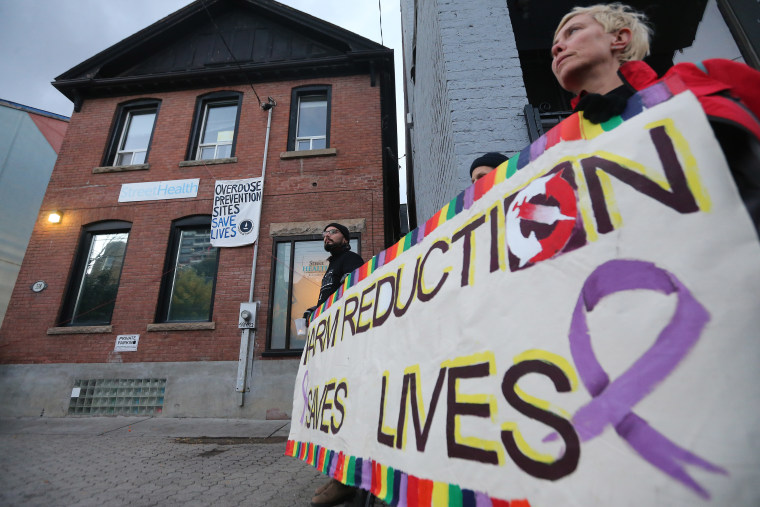As the overdose crisis in the United States continues — more than 100,000 people died of overdose in 2021, a new record — the practice of harm reduction is gaining new traction as a possible solution to the crisis.
Harm reduction in the United States is widely acknowledged to have begun in the late 1980s, when syringe exchange programs were established at the state and local level. Since then, decades of research have shown that harm reduction techniques are an important way to help people who use drugs.
What is harm reduction?
Harm reduction is broadly defined by the Substance Abuse and Mental Health Services Administration as an approach that "emphasizes engaging directly with people who use drugs" and works to "improve the physical, mental and social wellbeing of those served" by offering various forms of care.
José Benitez, the executive director at Prevention Point, a harm reduction program in Philadelphia, called the approach "a philosophy" that "strives to meet people where they are."
"Some people are ready for treatment, some people are not, and no matter where they are in that spectrum, harm reduction is to meet people where they are," Benitez said. " We're not so focused all the time on the drug use, (which we see as) just part of people’s lives. We really get to focus on the healthcare issues ... in a non-judgmental fashion."
Harm reduction doesn't apply to just drug use: Experts interviewed for this story also said the tenets of harm reduction can be applied to sex, COVID-19 and even driving: Shreeta Waldon, the executive director of the Kentucky Harm Reduction Coalition, said that she often starts harm reduction talks with a comparison to child's booster seats.
"People said 'We need (young children) to be in a seat, not a car seat because they're not a baby, they need to be in a seat that adequately supports them ... in case there's an accident,'" Waldon said. "Well, that's prevention, right?"
What are the tools used in harm reduction?
The tools used in harm reduction can vary based on the location of the organization, the population served and more. One of the most essential tools for harm reduction are syringe exchange programs or programs that give away clean needles, since they can prevent the spread of blood-borne illnesses like HIV.
Other useful tools include testing strips, which help drug users determine if there is fentanyl, a strong synthetic opioid, in drugs, and naloxone, a medication that reverses opioid overdoses. Naloxone is available in either a nasal spray or injectable form.
Harm reduction services also work to offer psychological and physical care: Different organizations have different services, but provide everything from free meals to P.O. boxes to access to mental health counselors and HIV or hepatitis C care.
"Just making a meal available to people is harm reduction," said Benitez, who said that Prevention Point also offers a "judgment-free, low barrier shelter" for people who inject drugs and collects mail for people who may not have a permanent address. "(We provide) things that you'd normally find in regular health clinics, but most of the time, the injecting drug use community isn't welcome in those traditional health settings, so they come here and it's welcoming and non-judgmental."
The organizations interviewed for this story also emphasized their ability to connect with community members using outreach teams and mobile units that allow them to bring supplies and more to people who use drugs. They also use their organizations to educate the public.
"You cannot deal with drug use and not see it as a public health issue," said Paula Santiago, the executive director of VOCAL-NY, a harm reduction service in New York City, who was in the middle of parking the group's outreach van in Brooklyn while she spoke with TODAY.
How does one practice harm reduction?
Harm reduction isn't just the purview of dedicated organizations and government agencies. The best way to practice harm reduction, experts agreed, was to follow the central tenets of meeting people where they are and offering help in a non-judgmental fashion.
Santiago emphasized that any person can be a part of the solution by simply getting trained in the use of Narcan, the nasal version of naloxone, and regularly carrying it.
"Every single person should carry Narcan, because you never know when an overdose is going to take place. If we have a better understanding about overdose prevention and everybody is equipped with Narcan kits, we could save lives throughout the United States," she said. "You should have a Narcan kit, because you never know whose life you could save."
Related:
